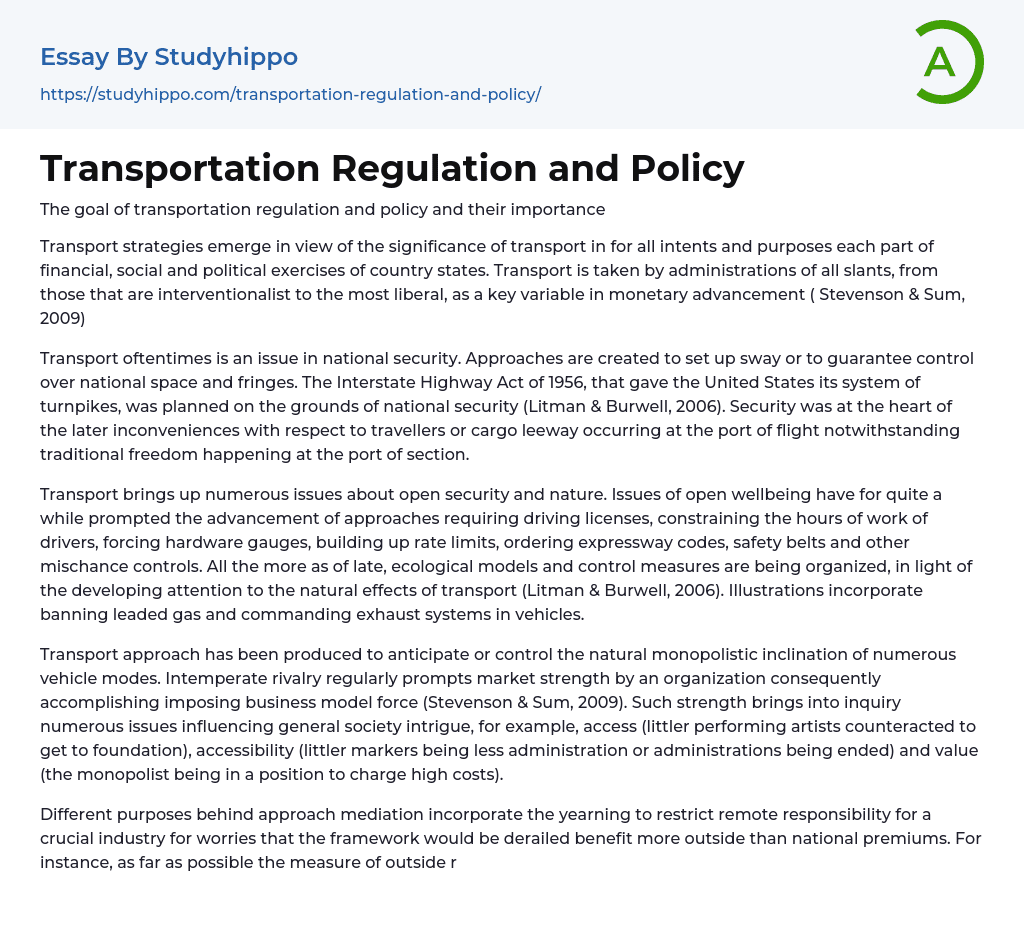The significance and importance of transportation regulation and policy
Transport strategies are developed to address the vital role of transportation in the economic, social, and political activities of countries. Governments of different ideologies, ranging from interventionist to liberal, recognize the key role of transport in promoting economic development (Stevenson & Sum, 2009). Additionally, transportation often influences national security and policies are created to establish dominance or maintain control over national borders and territories.
The Interstate Highway Act of 1956, which established the U.S. turnpike system, was initiated for national security reasons (Litman & Burwell, 2006). The security concerns later resulted in inconveniences for travelers and cargo transportation at the airport and port of entry. Transportation raises numerous issues regarding public safety and the environment. Public safety concerns have long led to the development of policies requiring driver's licenses, reg
...ulating drivers' working hours, enforcing equipment standards, implementing speed limits, establishing highway codes, seat belts, and other accident controls. More recently, environmental standards and control measures are being prioritized due to increased awareness of transport's environmental impacts (Litman ; Burwell, 2006). Examples include the prohibition of leaded gas use and the requirement for catalytic converters in vehicles.
The transportation approach aims to predict or regulate the natural monopolistic tendency of multiple modes of transportation. Excessive competition often leads to market dominance by a company, resulting in monopoly power (Stevenson ; Sum, 2009). This dominance raises concerns about issues affecting the public interest, such as access (smaller players being prevented from accessing infrastructure), availability (smaller indicators providing less service or services being terminated), and pricing (the monopolist being able to charge high prices). Policy intervention is also motivated by th
desire to limit foreign ownership in a critical industry to prevent the system from benefiting foreign interests more than national interests. For instance, it restricts foreign ownership of domestic airlines to a maximum of 49%, with additional controls up to 25%. Other countries have similar restrictions.
Transportation policies are developed to address various issues including national security, public safety, and the environment.
National security
Transport raises concerns about public safety and the environment. In response to public safety concerns, policies have been implemented to require driving licenses, regulate driver work hours, establish equipment standards, set speed limits, enforce highway codes, and promote the use of safety belts and other accident prevention measures. In recent years, there has also been a focus on environmental standards and control measures to ensure the safety of imported/exported goods and uninterrupted production.
Public safety
Measures have been taken to enhance public safety, such as enforcing the use of seat belts in vehicles, installing effective lighting along roads, and creating designated pedestrian crossings and flyovers. These measures have made transportation more convenient while reducing the number of accidents and ensuring timely completion of daily tasks.
The Environment
Policies are in place to promote the use of unleaded fuel in vehicles to prevent the emission of harmful carbonated gases that contribute to acidic rains. Vehicles are also equipped with exhaust pipes to release gas emissions safely.
This has helped to prevent additional legal expenses for the negative impacts of gaseous emissions.
Monopolies
A transportation approach has been developed to anticipate or regulate the natural tendency towards monopolistic behavior in various modes of transportation
(Dunn, 2015). Intense competition often results in market dominance by a company, giving them monopoly power. This has affected the pricing mechanisms of these transportation modes, causing a decrease in revenue.
The text below includes references in an HTML format.
References
- Stevenson, W. J., ; Sum, C. C. (2009). Operations management (Vol. 8). Boston, MA: McGraw-Hill/Irwin.
- Sinha, K. C., ; Labi, S. (2011). Transportation decision making: Principles of project evaluation and programming.
John Wiley ; Sons.
Litman, T., ; Burwell, D. (2006). Issues in sustainable transportation. International Journal of Global Environmental Issues, 6(4), 331-347.
Dunn, W. N.
(2015). Public policy analysis. Routledge.
- Cars essays
- Bicycle essays
- Rms Titanic essays
- Renault essays
- Truck essays
- chrysler essays
- The city essays
- Racing essays
- American Dream essays
- Barriers To Entry essays
- Capitalism essays
- Central Bank essays
- Compensation essays
- Consumerism essays
- Economic Development essays
- Economic Growth essays
- Economic Inequality essays
- Economic System essays
- Economy essays
- Employment essays
- Export essays
- Finance essays
- Free Trade essays
- Gross Domestic Product essays
- Human Development essays
- Income Inequality essays
- Industry essays
- Inflation essays
- International Business essays
- International Trade essays
- Macroeconomics essays
- Materialism essays
- Max Weber essays
- Microeconomics essays
- Minimum Wage essays
- Monetary Policy essays
- Monopoly essays
- Pricing essays
- Profit essays
- Recession essays
- resources essays
- Taxation essays
- Trade essays
- Unemployment essays
- Warehouse essays
- World economy essays
- Aviation essays
- Emergency Management essays
- Health Insurance essays
- Insurance essays




